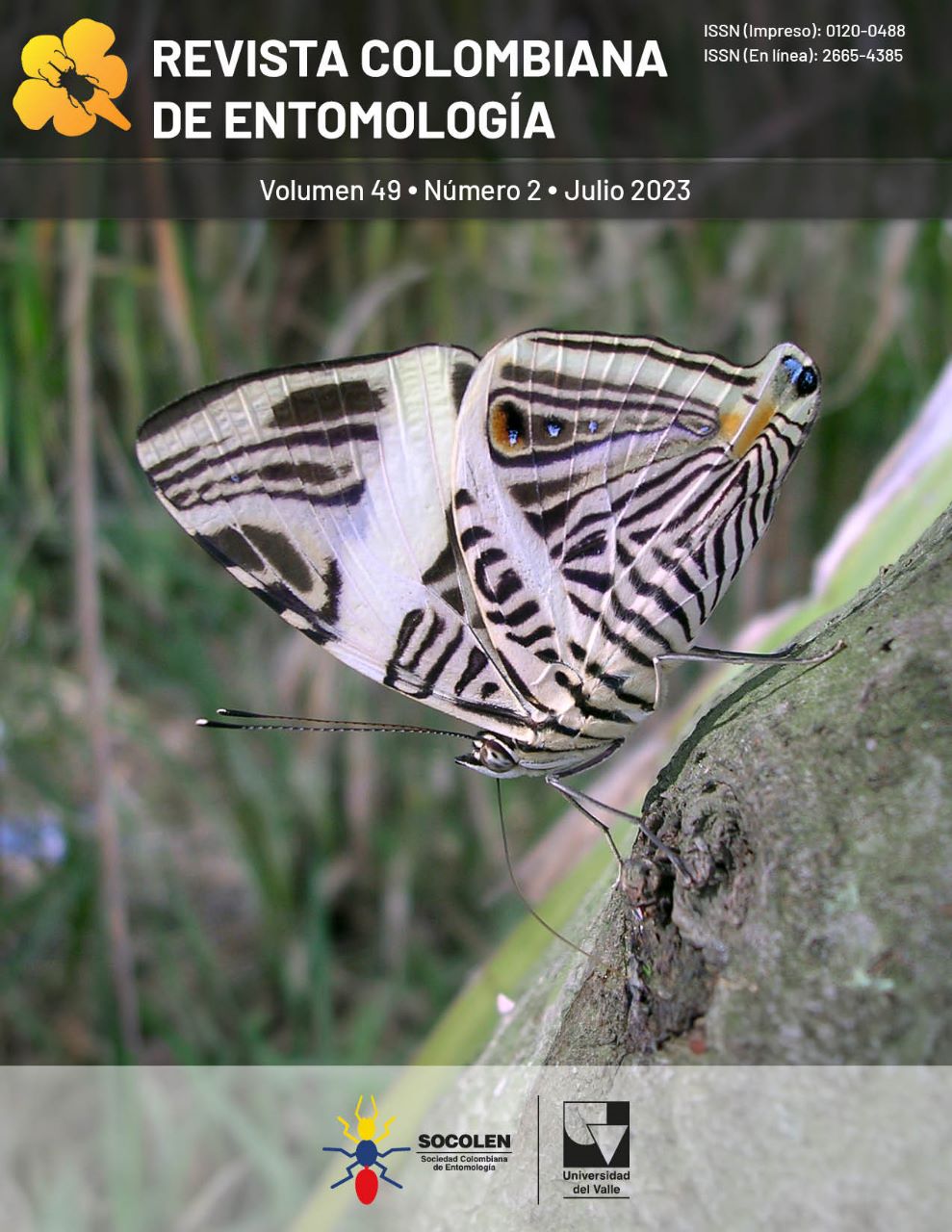Testing Opuntia ficus-indica genotypes for resistance against Dactylopius coccus (Hemiptera: Dactylopiidae)
Keywords:
Cochineal insect, cactus pear, resistant, scale insect, pest managementMain Article Content
Besides being a beneficial insect when it is cultivated for the production of carminic acid, the cochineal
insect (Dactylopius coccus) is also a threat to the prickly pear cactus (Opuntia ficus-indica), a plant that is extremely important as a source of food, cattle feed, income, and soil and water conservation. A crucial component of an integrated pest management approach is the use of resistant varieties. In a greenhouse, a test for resistance of four cactus pear genotypes to cochineal insects was conducted at the University of Guadalajara, Center of Sciences for Biology and Agriculture. Three of these genotypes (‘Punto 1’, ‘Punto 2’, and ‘Sandate 2’) were shown to be non-hosts for D. coccus. These genotypes can be used for further research and development purposes of prickly pear cactus.
Akroud, H., Sbaghi, M., Bouharroud, R., Koussa, T., Boujghagh, M., & El Bouhssini, M. (2021). Antibiosis and antixenosis resistance to Dactylopius opuntiae (Hemiptera: Dactylopiidae) in Moroccan cactus germplasm. Phytoparasitica, 49(4), 623-631. https://doi.org/10.1007/s12600-021-00897-w DOI: https://doi.org/10.1007/s12600-021-00897-w
Barbera, G., Carimi, F., & Inglese, P. (1992). Past and present role of the Indian-fig prickly-pear (Opuntia ficus-indica (L.) Miller, Cactaceae) in the agriculture of Sicily. Economic Botany, 46(1), 10-20. https://www.jstor.org/stable/4255403 DOI: https://doi.org/10.1007/BF02985249
Batista, M. C., do Nascimento, R., de Almeida, I. V. B., de Medeiros, L. T. V., Souza, J. T. A., de Oliveira Santos, J. P., Cartaxo, P.H. de A., & Araújo, J. R. E. S. (2022). Production and selection of accessions of Opuntia spp. with resistance to false carmine cochineal. Comunicata Scientiae, 13, e3869-e3869. https://doi.org/10.14295/cs.v13.3869 DOI: https://doi.org/10.14295/cs.v13.3869
Belay, T. (2015). Carmine cochineal: fortune wasted in northern Ethiopia. Journal of the Professional Association for Cactus Development, 17, 61-80. https://doi.org/10.56890/jpacd.v17i.62 DOI: https://doi.org/10.56890/jpacd.v17i.62
Berhe, Y. K., Aymut, K. M., Gebremariam, B. L., Gebreziher, H. G., Siyum, Z. H. (2020). Introduction of carmine cochineal to northern Ethiopia, current status of infestation on cactus pear, and control measures. International Journal of Botany Studies, 5(1), 32-38. https://www.botanyjournals.com/archives/2020/vol5/issue1/4-6-42
Berhe, Y. K., & Siyum, Z. H. (2022, September). Dactylopius coccus Costa pest of beles, and ways for sustainable pest management and development in Tigray, Ethiopia. In X International Congress on Cactus Pear and Cochineal: Cactus the New Green Revolution in Drylands 1343 (pp. 577-584). DOI: https://doi.org/10.17660/ActaHortic.2022.1343.73
Berhe, Y. K., Portillo, L., & Vigueras, A. L. (2022). Resistance of Opuntia ficus-indica cv ‘Rojo Pelon’ to Dactylopius coccus (Hemiptera: Dactylopiidae) under greenhouse condition. Journal of the. Professional Association for Cactus Development, 24, 293-309. https://doi.org/10.56890/jpacd.v24i.509 DOI: https://doi.org/10.56890/jpacd.v24i.509
Bouharroud, R., Amarraque, A., & Qessaoui, R. (2016). First report of the Opuntia cochineal scale Dactylopius opuntiae (Hemiptera: Dactylopiidae) in Morocco. EPPO Bulletin, 46(2), 308-310. https://doi.org/10.1111/epp.12298 DOI: https://doi.org/10.1111/epp.12298
Brutsch, M. O. (1997). The Beles or cactus pear (Opuntia ficus indica) in Tigray Ethiopia. Journal of the Professional Association for Cactus Development, 2(1997), 130-141. https://www.jpacd.org/jpacd/article/view/177
Gebremeskel, G., Getachew, A., & Firew, T. (2013). Assessment of potential of cactus pear (Opuntia ficus indica) as livestock feed in northern Ethiopia. Livestock Research for Rural Development, 25(2), 1-10. http://www.lrrd.cipav.org.co/lrrd25/2/moen25026.htm
Gusqui Mata, R. C. (2013). Eficacia de los métodos de infestación y el número óptimo de hembras madre por cladodio de tuna (Opuntia ficus-indica), para la producción de grana cochinilla (Dactylopius coccus Costa), bajo invernadero en la comunidad Chingazo Alto del Cantón Guano, Provincia de Chimborazo. [B.Sc. Tesis, Escuela Superior Politécnica de Chimborazo, Ecuador]. http://dspace.espoch.edu.ec/handle/123456789/2232
IPPC. International Plant Protection Committee. (2010). Lista de plagas reguladas para Chile-Resolución SAG No. 792 de 2007. https://www.ippc.int/en/countries/chile/reportingobligation/2012/12/lista-de-plagas-reguladas-para-chile-resolucion-sag-n-792-de-2007/
Kondo, T. (2022). Family: Dactylopiidae. In T. Kondo, & G.W. Watson (Eds.), Encyclopedia of Scale Insect Pests (pp. 388-390). Wallingford, Oxfordshire, CABI. https://www.cabidigitallibrary.org/doi/abs/10.1079/9781800620643.0004j DOI: https://doi.org/10.1079/9781800620643.0004j
Kuti, J. O. (1990). Screening Opuntia accessions for resistance to cottony cochineal insects (Dactylopius species). HortScience, 25(9), 1076-1076. https://doi.org/10.21273/HORTSCI.25.9.1076d DOI: https://doi.org/10.21273/HORTSCI.25.9.1076d
Mazzeo, G., Nucifora, S., Russo., A., & Suma, P. (2019). Dactylopius opuntiae, a new prickly pear cactus pest in the Mediterranean: An overview. Entomologia Experimentalis et Applicata, 167(1), 59-72. https://doi.org/10.1111/eea.12756 DOI: https://doi.org/10.1111/eea.12756
Méndez-Gallegos, S., Tarango-Arámbula, L. A., Carnero, A., Tiberi, R., & Díaz-Gómez, O. (2010). Growth parameters of cochineal Dactylopius coccus Costa reared in five cactus pear cultivars Opuntia ficus-indica Mill. Agrociencia, 44(2), 225-234. https://www.scielo.org.mx/scielo.php?pid=S1405-31952010000200011&script=sci_abstract&tlng=en
Musengi, K., Mbonani, S., & Byrne, M. J. (2021). Host suitability of three Opuntia taxa for the Dactylopius opuntiae (Hemiptera: Dactylopiidae) ‘stricta’ lineage. Biocontrol Science and Technology, 31(11), 1161-1173. https://doi.org/10.1080/09583157.2021.1932747 DOI: https://doi.org/10.1080/09583157.2021.1932747
Pacheco da Silva, V. C., Suma, P., Claps, L. E., & Kondo, T. (2022). Dactylopius spp. (Hemiptera: Coccomorpha: Dactylopiidae). In T. Kondo, & G.W. Watson (Eds.), Encyclopedia of Scale Insect Pests (pp. 390-394). Wallingford, Oxfordshire, CABI.
Primo, L. G. S. (2020). Seleção de acessos de Opuntia spp. com resistência à cochonilha-do-carmin Dactylopius opuntiae. [Doctoral dissertation, Universidade Federal de Viçosa]. 1973-S175. https://locus.ufv.br//handle/123456789/29966
Sabbahi, R., & Hock, V. (2022). Control of the prickly pear cochineal, Dactylopius opuntiae (Cockerell), in Morocco: An overview. Journal of Plant Diseases and Protection, 129(1), 1-8. https://doi.org/10.1007/s41348-022-00655-y DOI: https://doi.org/10.1007/s41348-022-00655-y
Stintzing, F. C., & Carle, R. 2005. Cactus stems (Opuntia spp.): A review on their chemistry, technology, and uses. Molecular Nutrition & Food Research, 49(2), 175-194. https://doi.org/10.1002/mnfr.200400071 DOI: https://doi.org/10.1002/mnfr.200400071
Torres, J. B., & Giorgi, J. A. (2018). Management of the false carmine cochineal Dactylopius opuntiae (Cockerell): perspective from Pernambuco state, Brazil. Phytoparasitica, 46(3), 331-340. https://doi.org/10.1007/s12600-018-0664-8 DOI: https://doi.org/10.1007/s12600-018-0664-8
Tovar, A. M., Pando-Moreno, M., & Garza, C. (2005). Evaluation of three varieties of Opuntia ficus-indica (L) Miller as hosts of the cochineal insect Dactylopius coccus Costa (Homoptera: Dactylopiidae) in a semiarid area of northeastern Mexico. Economic Botany, 59(1), 3-7. https://doi.org/10.1663/0013-0001(2005)059
Vigueras, A. L., Llanderal-Cázares, C., & Portillo, L. (2005). Cochineal (Hemiptera: Dactylopiidae) production. Scientia CUCBA, 7(2), 99-103.
Downloads

This work is licensed under a Creative Commons Attribution-NonCommercial-ShareAlike 4.0 International License.
Authors retain the copyright on their work and are responsible for the ideas expressed in them. Once a manuscript is approved for publication, authors are asked for a publication license for the term of legal protection, for all territories that allows the use, dissemination and disclosure of the same.

